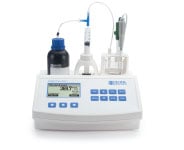
In the past 75 years, the worldwide human population has increased from approximately 2.5 billion to over 7 billion people. Population increase, the resulting increase in use of natural resources, and human-produced waste have significantly impacted our natural environment. One of the most vital resources that humans require to live is water.
Ironically enough, one of the most common human effects on the environment is pollution of water. One indication of water pollution is a high acidity level. Water bodies all around the world consist of varying levels of acidity due to natural factors such as landscape position and slope, watershed size, geology, and soil composition, as well as human pollution.
Acidity, the buffering capacity of a substance to resist a change in pH when reacted with a strong base, is determined by titration with sodium hydroxide (NaOH) and commonly expressed as mg/L or meq/L calcium carbonate (CaCO₃). Acidity of water originates from various sources: weak organic acids, such as dissolved CO₂ as carbonic acid, acetic acid, and tannic acid; strong mineral acid, such as sulfuric and hydrochloric acids; and metal salts from iron, aluminum, and manganese. High levels of strong mineral acids are indicative of anthropogenic pollution. When atmospheric pollutants from the burning of fossil fuels, such as sulfur dioxide (SO₂) and nitrogen oxides (NOx), are emitted into the atmosphere, they combine with water and ozone to become sulfuric and nitric acid.
During precipitation events, these acidic counterparts are then deposited on the ground and in water bodies in the form of acid rain. Improperly managed mining activities also contribute to acidity levels, where acid mine drainage releases metals and acids into surrounding water systems. High levels of water acidity affect various aspects of the water body’s ecosystem, from chemical reaction rates to biological processes in almost every living organism. Fish, specifically, can only withstand a very narrow range of acidity before biological processes are affected and fatality occurs. If the water body is used for drinking water treatment, high acidity and a low pH can lead to pipe corrosion.

An environmental state agency contacted Hanna Instruments for a means of measuring various water quality parameters. The agency was overseeing a statewide project to determine the health of several surface water bodies in their area and required equipment for field measurements of pH, temperature, and dissolved oxygen. After speaking with the customer for some time, the Hanna Sales Representative determined that they were also testing for acidity in the laboratory by manual titration with an indicator dye. The sales representative recommended the Mini Titrator for Measuring Titratable Acidity in Water - HI84530.
Based on the Standard Methods for the Examination of Water and Wastewater Method 2310B, the HI84530 operates under the same principles as the manual titration, with options for fixed pH endpoints at 3.7 pH for strong acidity (methyl orange acidity) and 8.3 pH for total acidity (phenolphthalein acidity). The customer appreciated the titrator had designated ranges for low acidity water (15.0 to 400 mg/L CaCO₃) and high acidity water (300 to 4000 mg/L CaCO₃) for optimal resolution and reagent consumption.
The HI84530 offered increased accuracy and repeatability compared to their manual titration. This was due to the use of the Refillable Combination pH Electrode - HI1131B to determine the precise pH endpoint, and the piston driven syringe dosing pump to more accurately dispense and track titrant volume. The optional tutorial mode on the instrument provided peace of mind for the customer since several inexperienced undergraduate students from a local university would be assisting with the analysis. However, as perhaps the most definitive feature, the customer was thrilled with the affordable price of the mini titrator, allowing them to fit it into their yearly budget.
That's why we've dedicated our blog as a helpful resource for you to use! Catch up on the latest products, explore industry trends, discover testing tips, learn how to improve results, and more. Got questions? Email sales@hannainst.com.
